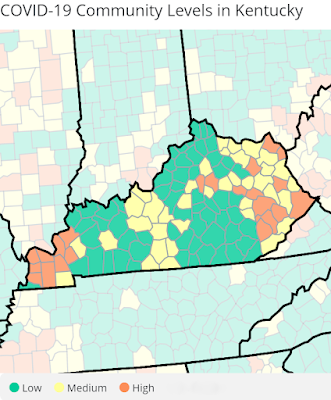 |
| Centers for Disease Control and Prevention map |
Kentucky Health News
The number of Kentucky counties on the federal Covid-19 risk map continues to increase, with almost two-thirds estimated to have either a high or a medium level of risk.
Gov. Andy Beshear cautioned at his weekly news conference that "There is a lot of Covid out there."
"So watch this," he said. "Make decisions to protect yourself, get tested if you feel sick and certainty don't go to work or out in public if you are sick."
Forty-three Kentucky counties are orange on the latest Centers for Disease Control and Prevention risk map, indicating a high level of risk. That's up from 22 on last week's map.
Thirty-five counties are yellow, indicating a medium level of risk. Last week, 37 were yellow.
The rankings are based on new coronavirus cases, hospital admissions and hospital capacity and is the map that Kentucky's officials say should be used when deciding on what types of precautions to take to protect yourself and others from the disease.
A number of counties have been orange for three weeks in a row, including McCracken, Livingston, Lyon, Woodford, Fayette, Greenup, Boyd, Wolfe, Breathitt, Leslie and Perry.
Other orange counties are Hickman, Carlisle, Ballard, Graves, Calloway, Marshall, Trigg, Crittenden, Hopkins, Muhlenberg, McClean, Ohio, Hancock, Grayson, Monroe, Barren, Metcalfe, Hart, Larue, Hardin, Bourbon, Clark, Powell, Carter, Lawrence, Martin, Pike, Magoffin, Floyd, Letcher, Harlan and Bell.
The yellow counties on this week's map are Fulton, Todd, Christian, Caldwell, Webster, Henderson, Daviess, Allen, Warren, Jefferson, Adair, Taylor, Marion, Nelson, Washington, Mercer, Anderson, Franklin, Owen, Harrison, Nicholas, Montgomery, Bath, Menifee, Madison, Rowan, Johnson and Knott.
Meade, Breckinridge, Jessamine, Scott, Owsley, Lee and Lewis are yellow for the third week in a row.
In orange counties, state guidelines call for wearing masks in indoor public spaces, limiting in-person gatherings, limiting the size of gatherings, and social distancing.
 |
| CDC map |
Kentucky's weekly pandemic report, released on Monday, showed the state had an average of 1,368 new cases a day last week, up 21% from the week before. The report showed the lowest number of weekly Covid-19 deaths in the last 11 months and hospital rates that remain low, but inching up. Beshear said the increase in hospitalizations is not expected to continue. The positive-test rate increased to 13.36%, up from 12.45% the prior week.



















